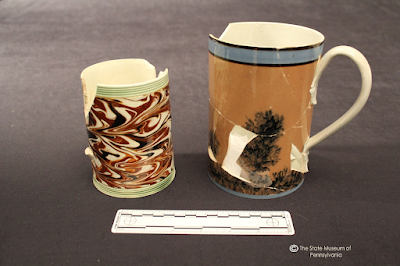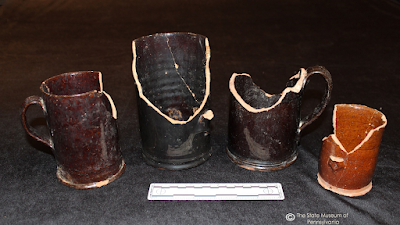Prior to the 16th century the fermentation of
malts, hops, and water (Scientific America, 1859) was done in a warmer climate
using Saccharomyces Cerevisiae, otherwise known as brewer’s yeast. This process is known as surface fermentation
because the yeast collects at the top like a “scum” (Scientific America,
1881). It was a faster process that was
less temperature sensitive and produced ale.
Sometime in the 1500’s beer makers discovered a slower
fermentation process that used a different yeast Saccharomyces Pastorianus
to produce lager. This slower process is
referred to as under fermentation, where the yeast collected under the liquid
as opposed to at its surface. The process is also referred to as bottom-fermentation. This beverage was more temperature sensitive
and required a cooler setting between 40° to 50° Fahrenheit, meaning that it was
typically prepared between October to May (Scientific America, 1881). The term
lager is derived from the German word lagern, meaning “to store”. The
cold temperatures of northern Europe were ideal for this winter activity. Both men
and women produced lagers and ales.
The Virginia Company colonists at Jamestown, Virginia were producing ales as early as 1607, some more successfully than others. The basic ingredients of water, grain (barley, corn oats, wheat or rye), sugar (molasses or honey), and hops in the right combination were boiled for several hours. Yeast was sprinkled on during the cooling process. The boiling of this mixture killed bacteria that were present in drinking waters which were a health hazard in urban colonial settlements.
 |
Dawson's Brewery, Northwest Corner of 10th and Filbert
Streets, Philadelphia, 1831. Library of Congress |
Archaeologists at the University of Pennsylvania examined residues on ceramic collections and discovered new information about the earliest brewing of beer and wine. Improved methods of specialized analysis have yielded information regarding early trade, use of honey in brewing, and the partaking of the beverage prior to the entombment of King Midas’s father, Gordion around 740-700 BC. Stanford archaeologists have examined 13,000-year-old stone mortars from a graveyard site in Israel and recovered evidence of brewed beers predating cultivated cereals. In essence, the theory is that the demand for brewed beer was a motivating factor to the domestication of cereals. Rituals and feasting are important elements of social organization, in this case it demonstrates their bond to hunter-gatherer ancestors.
The collections of The State Museum of Pennsylvania, Section of Archaeology contain extensive examples of drinking vessels suitable for enjoying these delectable drinks. One of the most common forms recovered from sites across the Commonwealth is the tankard. Tankards are cylindrical drinking vessels that come in a variety of sizes that are made from many materials including wood, ceramics, glass, and metal. Some examples may include hinged lids, but this is not necessarily required to be considered a tankard. It is suggested that lids were attached to keep foreign debris such as plaster, dirt, and insects out of the beverage especially when consumed in more rustic environs. Another interesting design of some tankards, especially those made of metal, was the inclusion of a glass bottom. Some suggest that this was included for the consumer to be able to see the approach of danger or enemies, but others think it may have been a way to evade the ‘the king’s shilling’ which could be slipped into a drink and then used to force the conscription of the consumer into the army or navy.
Have you ever heard the phrase “watch your P’s and Q’s”? It is believed that this colloquialism harkens back to a time when the size of your tankard could accommodate up to 4 pints or two quarts of your favorite beverage and if a bartender reminded you to “mind your P’s and Q’s” they were telling you to watch how much you were drinking.
 |
Mocha pearlware tankards from the Philadelphia Market
Street Collection These tankards are a beautiful example of pearlware with
a mocha design and date to the early 19th century. |
These stoneware tankards below are of the Nottingham-type with incised and rouletted designs suggesting they date to the 18th century. The vessel farthest to the right is a bit unusual in design as it’s gray body and darker metallic glaze may indicate it was over fired.
 |
Stoneware tankards from the Philadelphia Market Street
Collection, The State Museum of Pennsylvania. |
And last but certainly not least, a handsome example of a glass tankard. This example of a trailed glass tankard was created by applying hot trails of glass onto the vessel’s body to create the design. This vessel likely dates to the late 18th century and was recovered during excavations at Pennsbury Manor.
 |
Glass tankard from the Pennsbury
Manor in Bucks County |
References:
Brewer, Bob (2014, July 30). Lager: The Most Popular Beer on the Planet. Anchor Brewing. https://www.anchorbrewing.com/blog/a-history-of-lager/
Li Liu, Jiajing Wang, Danny Rosenberg, Hao Zhao, György Lengyel, Dani Nadel,
Fermented beverage and food storage in 13,000 y-old stone mortars at Raqefet Cave, Israel: Investigating Natufian ritual feasting, Journal of Archaeological Science: Reports, Volume 21, October 2018, pages 783-793.
Scientific America. (1859, July 16). Lager Beer. Scientific America 1(3): 35
Scientific America. (1881, March 26). Lager Beer. Scientific America 44(13): 192-193



No comments:
Post a Comment